
Adèle Exarchopoulos, left, and Léa Seydoux in BLUE IS THE WARMEST COLOR (All photos: Cannes Film Festival)
The main difference that sets the Cannes Film Festival apart from other fests is the anticipation: you want to see the films debuting in the competition, especially if they are directed by the likes of the Coen brothers, Alexander Payne, Roman Polanski, and Asghar Farhadi, to name four. Few shots in the dark here.
There was a real race this year for the awards bestowed by a jury headed by Steven Spielberg. The half-hour televised ceremony was as glitzy and cheesy as its American counterparts, but since only about a half-dozen awards were handed out, it moved at a fast pace. But oh, the banter. Before revealing the top price, the Palme d’Or, the poor mistress of ceremonies, Audrey Tautou, intoned “Ooo” (beat) “La” (beat) “La,” and repeated it even more slowly and to lesser effect before announcing Uma Thurman, a Cannes red carpet fixture, who, in turn, introduced Spielberg to reveal the winner.
Going into the ceremony, Blue Is the Warmest Color, the victor, was ahead in the running in the French critics’ poll. Its director, Abdellatif Kechiche (The Secret of the Grain), has previously won major awards within the French film industry, but not at Cannes. His new film was based on a popular graphic novel, where a 17-year-old working-class girl falls in love with a woman, an older (21ish) middle-class arts student. It’s lust at first sight when she notices Emma crossing the street in the arms of a woman. With a mop of blue hair and delicate blond eyebrows, the striking Emma looks ethereal.
Without precedent, the jury handed out the award to not only the film’s director but to its two lead actresses as well, which was an unusual but a completely appropriate acknowledgement of their contributions, especially considering how they were filmed in Kechiche’s well-established style: long hand-held tracking shots filmed very, very close to the face. (But really, it’s not the greatest idea when people are filmed eating, which they do here a lot.) Although the scenes naturally build to a conflict, an internal editorial voice creeps in, voicing what scenes to cut here and there. In Kechiche’s previous films, which are also three hours long, the momentum of the story gathers steam, but this time around it ambles.
The way that the camera follows 19-year-old actress Adèle Exarchopoulos (completely uninhibited)—like it was her shadow—draws you into her thoughts and emotions, but the camera also reveals too much. Both of the film’s actresses give 100 percent so there’s really no mystery to their motivations. Forget the on-screen sex, it’s the emotions that are too explicit.
But speaking of the former, the first bedroom scene between Exarchopoulos (as Adèle) and her co-star Léa Seydoux brings a new level of depicting sex on screen. It’s not pornographic, yet neither does it leave anything to your imagination—but at almost 10 minutes long, it’s gratuitous. It didn’t hurt the film to achieve immediate notoriety, though. It’s noteworthy that an earlier sex scene with Adèle and a man is chaste in comparison.
Another French production featuring sex, some would call hardcore, premiered in the concurrent section Un Certain Regard, which generally programs more unconventional films (though not based on what I saw). From what I’ve heard, Stranger by the Lake, set around a lakeside gay cruising ground for hookups and homicide, flashes penises for two hours. A French colleague said that he thought the reaction to the nudity and the male-on-male oral sex by the woman sitting nearby was just as entertaining as the movie. The often nude male actors reportedly had body doubles for the money shots. The actresses in Blue just had themselves.
Thankfully, Blue is not a coming-out retread. Kechiche depicts the story of a couple; the gender and sexual preference is almost incidental. Indeed, Adèle introduces her girlfriend to her parents as her philosophy tutor, and the more politically aware Emma plays along. The couple is out and proud at a Lille gay rights march, but Adèle’s real coming-out epiphany occurs in the bedroom with Emma.
Kechiche has stated that the major obstacle in their relationship is their social background, which informs their personal aspirations. I saw less of a class contrast than a power play between two opposites. Even though there are only a few years between them, the gap between 17 and 21 is huge in terms of life experience and maturity. Emma molds her younger lover, introducing her to art and the joys of eating oysters (really), though Adèle is no rube and is very confident in what she likes (Marivaux, please) and is already politically minded (say no to austerity measures). Though she’s young, Adèle has a certain strength that has nothing to do with intellect—she’s constantly being hit on by both men and women. When she ventures into a lesbian bar for the very first time, Emma has to fight off other women waiting to buy the high schooler a drink. It’s that attraction that adds some insecurity and a possible threat for Emma, and not whether Adèle can live up to some sort of standard.
From Canada and in the Un Certain Regard section, Sarah Prefers to Run shares a lot in common with Blue. A track-and-field athlete, 20-year-old Sarah (Sophie Desmarais) moves to the big city of Montreal to attend McGill University, and marries a hometown boy so that both can receive a government stipend to support themselves while in school. He’s a congenial, happy-go-lucky, hearts-on-sleeve jock. She’s withdrawn and timid, except when she watches a female teammate sing karaoke, and her heart skips many beats—landing her in the hospital. The audience knows where this is going, and this quiet, unpretentious film leads to a climax when Sarah makes a simple, though life-changing, gesture. After a refreshingly brief 87 minutes, Sarah has finally made a decision for herself. Except for one awkward sex scene, the film is strictly PG. Even in a gym shower, the women wear bathing suits. However, the film reveals the limits of how compelling a passive lead character can be, especially compared to her husband-of-convenience and her extroverted teammates. Adèle in Blue doesn’t have this problem.
Though the Palme d’Or is arguably the most important European film award, Blue’s win doesn’t guarantee that it will represent France for the best foreign language film Oscar this year. France’s selection committee often picks both popular and commercial fare, though sometimes a Cannes winner is thrown into the mix. Although it lost the top prize, Asghar Farhadi’s new film, The Past, won the best actress prize for Bérénce Bejo (far from the frivolity of The Artist), and it’s as strong as A Separation, which won the Oscar just two years ago, making it a more likely pick, besides being the film that resonated the most for me.
Though it begins on a lower charged note than A Separation, it builds, taking off in the second half. A great novelist-as-filmmaker, Farhadi has written another mystery where every plot detail counts, beginning simply and innocuously enough. Ahmad (Ali Mosaffa) has returned from Iran to Paris for the first time in four years to sign his divorce from Marie-Anne (Bejo) and end their relationship on good terms, but given the film’s title, that may not be likely.
On the drive from the airport, he asks her if she has booked him a hotel room. She hasn’t. Why bother when he might cancel his plans—like he has before (about which she will remind him repeatedly). Instead, she’ll put him up in her suburban home—except she hasn’t warned him of her new living arraignments. And oh, can he please have a heart-to-heart with her teenage daughter from another marriage and find out what’s bothering her? Thus an enormous can of worms opens.
Like in Farhadi’s previous films, the moral waters become murky. Marie-Anne has a certain skill of dropping information bombs at the right moment, but Ahmad has an equally adept way of delivering a withering putdown. And in another similarity to A Separation, there’s an impromptu court scene of sorts that takes place in a café, an you won’t see the next development coming.
Emmanuelle Seigner gave Bejo strong competition in husband Roman Polanski’s breezy and confident adaptation of David Ives’ 2010 two-hander play Venus in Fur. Although there was only one female director in the competition section (Valeria Bruni Tedeschi’s wobbly Chekhovian A Castle in Italy), it was a very good year for actresses. On first appearance, Seigner’s character’s a mess, coming out of the rain dripping wet, wearing a black leather mini-dress and a dog collar. She’s dressed for an audition of a director/playwright’s version of Leopold von Sacher-Masoch’s 1870 novel Venus in Furs, named for the only article of clothing adorning the goddess in Titian’s Venus at a Mirror. Vanda (Seigner), perhaps not so coincidentally sharing the same name as novel’s dominatrix, calls the work “S & M porn” and asks if it was written in Austrian. She has no appointment, but somehow she has managed to get hold of the unpublished script.
Both Polanski and Seigner clearly set out to undermine the audience’s expectations of Vanda as she bulldozes her way onto the stage and transforms into an Austrian aristocrat, taking over the audition as well as the film, with Mathieu Amalric along for the humiliation as her befuddled, acquiescent, and awed foil.
As though mirroring the power shift between the play’s director and Vanda, Polanski has delivered the film to Seigner on a silver platter. The role of Vanda was originally created on stage by a younger actress, Nina Arianda, yet the casting of the older Seigner works to the film’s advantage. Vanda has been around the block more than a few times, and her anger and need for a job feel more justified. (Not to mention, she’s hilarious doing a thick Dietrich accent.) And this time, Polanski knows the jig is up: this is a beautifully framed mounting of a play, filmed elegantly with simply composed shots. He doesn’t try to overcompensate for the material’s visual limitations (it all occurs on one set—a darkened theater) by moving the camera about or looking for any way to open up the story, as he did in his previous play adaptation, Carnage.
The winner of the best screenplay award, Jia Zhangke took a giant step away from his more meditative films like Still Life or 24 City. (He’s a great purveyor of “slow cinema.” Stay with his films and they will resonate). The brutal A Touch of Sin is made up of four chapters, all based on real-life incidents of violence. The storytelling lucidly draws you into each of the blood-soaked storylines, and, remarkably, the film offers a scalding look at contemporary China by one its most acclaimed directors—and with government support (the Shanghai Film Group). I suppose that the title is ambiguous enough to finger point any moral lapse at the characters and not at the country’s communist/capitalist system. These are engrossing homilies against different types of private transgressions. Setting an unhinged tone, the film begins with a motorcyclist blocked at a road stop by men with hatchets. He needs to pay to pass through, but instead, the driver reaches for his gun and shoots them all dead.
The film gives new meaning to the term “blood money.” It also features a scene from a pragmatic marriage, where a wife advises her traveling husband, “If you use a call girl, use a condom” and the truism: “There’s no true love in sex work.” Only one of the chapters feels too rushed and a little under-developed. Overall, this was one film that I gladly wished was longer. It’s the best omnibus in quite some time. One question lingers, though: how many theaters will actually show this in China?
No other film was bloodier than Only God Forgives, my prize for the best title of the year (A Touch of Sin comes second). Ryan Gosling reunites with Danish director Nicholas Winding Refn for a garishly beautiful and modern Jacobean tale of revenge. Julian (Gosling) runs a Bangkok boxing club, and based on the sweat on Gosling’s forehead, the humidity is well over 100 percent. Like in their last effort, Drive, Gosling plays it cool, maybe too much so. He’s on no-emote control, revealing nothing when he learns his older brother is dead—his brains bashed out by a bat after he had raped and killed a teenage prostitute.
Kristin Scott Thomas as Julian’s mother from hell raises the energy of this art-house-pulp from its trippy lethargy. She’s a nightmarish caricature of American womanhood: mid-forties, bleached white blond hair, pink lip gloss, and stuffed in a way too tight dress. Blunt and coarse, she conspicuously compares the endowments of her sons, and uses language that would make a harden ex-con blush. She’s out for blood: to kill whomever ordered her son to die. That would be the police chief, the all-powerful judge of good and evil. Though morally and emotionally superficial, the film mesmerizes visually, with one of Julian’s hallucinations following another. It was booed at its debut press screening, but was politely, though tepidly, received at the screening I attended.
Overall, it was generally agreed that it was a very good year for American directors, even though James Gray’s The Immigrant received a mixed reception. First and maybe foremost, there is Alexander Payne’s Nebraska, a straightforward road trip with an embracing sense of melancholia, centered on a family that has forgotten or ignored its past. A placid but dutiful son takes his rarely-lucid, alcoholic, obstinate father from Montana back to the man’s Nebraska hometown on a dubious quest: dad’s convinced he has won a million dollar sweepstakes.
The black-and-white cinematography brings out the beauty of the flat Midwestern countryside and the starkness of small towns with closed up Main Streets. You might say it’s sentimental, but just a touch. These blunt, terse characters would never show too much emotion. (Dad explains to his son why he married: he liked to screw and mom’s Catholic, “So you do the math.”) This plain spoken film, along with the new Coen brothers offering, was a one-two punch for the U.S. Bruce Dern as Nebraska’s father deserved his best actor recognition, and his only competitor, based on what I saw, was the smooth Oscar Isaac in the Coens’ Inside Llewyn Davis.
Winner of the Grand Prix (second place), it has been compared to A Serious Man, but with a major difference. Folk artist Llewyn Davis is being tested, like a mid-century Job, but he’s the architecture of his own calumnies. He’s arrogant, self-centered, and a charming liar, but so single-minded and determined that this man/child disarms. Ironically, he can only express his vulnerabilities while singing with his guitar. He rigidly separates the emo vibe from his private life.
Formerly in a duo, he struggles for money and a place to crash, roaming from gig to gig, painfully carving out a solo career right before the Greenwich Village folk scene really hits it big on the charts. The beauty of the film is that the tone fluidly shifts from farce, tragedy, and the slightly screwball, and it contains great acoustic renditions of “A Hundred Miles” and the traditional “The Death of Queen Anne.” No matter where you would rank these latter two films among their respective directors’ best, both feature self-assured storytelling. And for all of the detours it takes, Inside Llewyn Davis may be the Coens’ saddest yet. Both films are awards season ready.


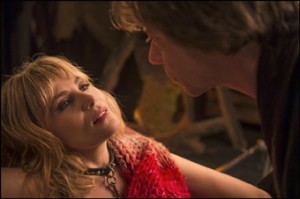
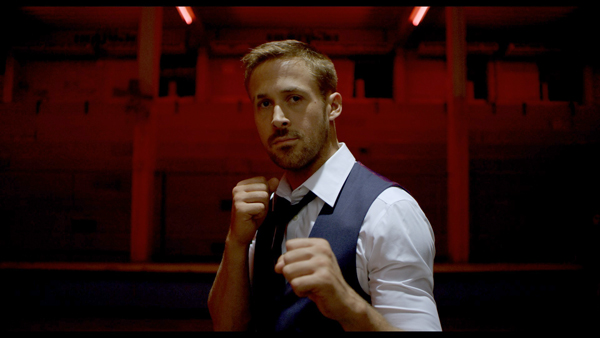
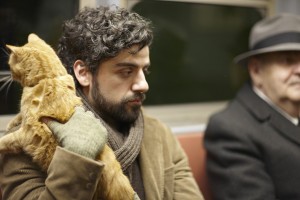



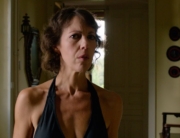
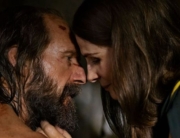
Leave A Comment